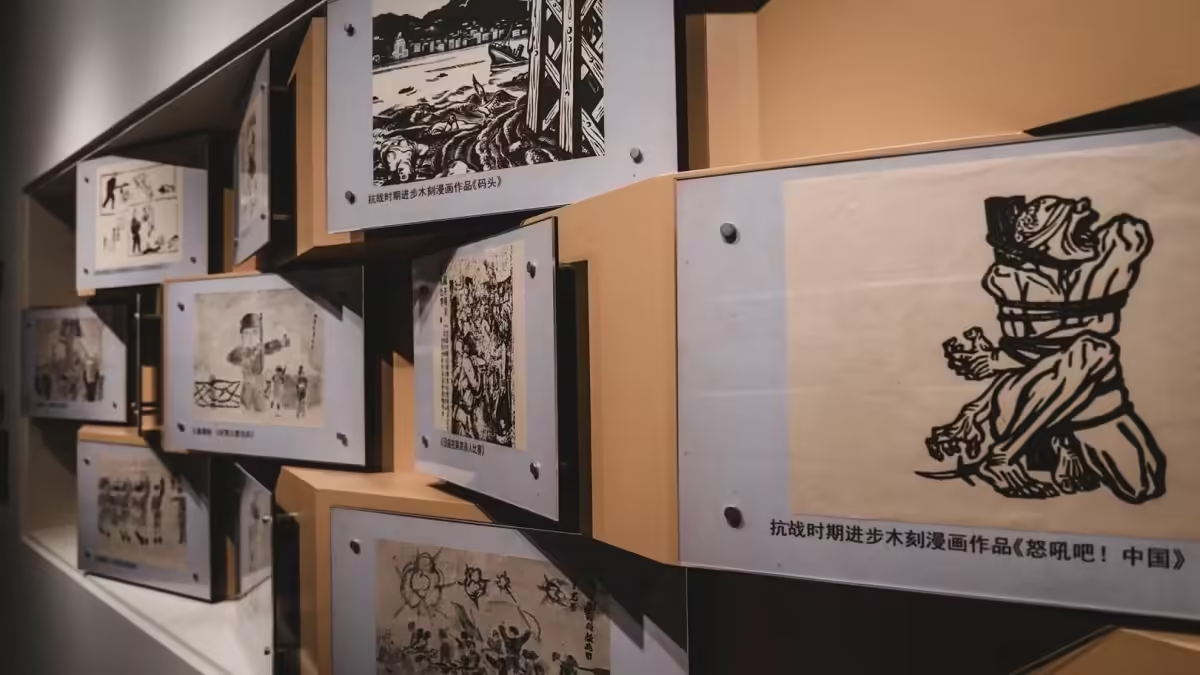The Hongyan Revolutionary Memorial Hall (红岩革命纪念馆) is situated along the banks of the Jialing River in Chongqing and was inaugurated in 1958. The museum hosts a comprehensive exhibition reflecting the history of the Communist Party of China (CPC), featuring displays such as “The Historical Artifacts Exhibition of the CPC Central Committee Southern Bureau and the Eighth Route Army Office in Chongqing” and “The Second Kuomintang-Communist Cooperation and Chongqing Negotiations Exhibition.” These exhibits showcase a wealth of articles, documents, and historical photographs related to the CPC delegation, the Southern Bureau, the Eighth Route Army Office, and the Xinhua Daily.
The hall also oversees several important sites, including the former site of the CPC Central Committee Southern Bureau, the Eighth Route Army’s Office in Chongqing, the Zhou Gong Museum at No. 50 Zengjiayan, the former Xinhua Daily office on Minsheng Road, and the signing location of the “Double Ten Agreement” at Guiyuan. These locations served as activity bases for the Southern Bureau of the CPC, playing a crucial role in consolidating and developing the Anti-Japanese National United Front and leading the people in revolutionary struggles during the Kuomintang’s rule.
Currently, the museum houses 874 cultural relics and over 1,500 important historical documents, including archives and historical literature. It also contains more than 20 types of periodicals from that time, such as Xinhua Daily and Mass Weekly, totaling 844 copies (including bound volumes and a few photocopies). Furthermore, there are 1,119 progressive books published by the Xinhua Daily, Sanlian Bookstore, and other publishers, as well as over 2,600 historical photographs.
Travel Information about Hongyan Revolutionary Memorial Hall
Ticket and Opening Hours
Admission: Free, with tickets available upon presenting valid identification.
Opening Hours: 9:00 AM to 5:00 PM (last entry at 4:30 PM).
Getting to the Memorial Hall
Location: No. 52, Hongyan Village, Yuzhong District, Chongqing.
Transportation: Take public buses 215, 216, 217, or 219 to the Hongyan Village stop.
Attraction Ratings
- Cultural Significance: ★★★★★
- Unique Features: ★★★★★
- Leisure Activities: ★★★
- Scenic Beauty: ★★
- Romantic Atmosphere: ☆
- Adventure and Excitement: ★
Highlights of Hongyan Revolutionary Memorial Hall
Hongyan Village No. 13 (Eighth Route Army Office in Chongqing)
Hongyan Village No. 13, originally known as Liu’s Garden, is located at 13 Hongyan Village, Huahulongqiao, Shapingba District. This three-story building was modified by staff from the Southern Bureau of the Communist Party and the Eighth Route Army’s Chongqing office. The structure was designed to adapt to the needs of their struggle while surrounded by enemy agents.
The unique features of the building include a pedal-operated electric bell installed in the right-side reception room, allowing for urgent notifications within the premises. A small door leading to the second floor is cleverly concealed behind the reception room door; when the main door is opened, it obscures the small door.
On the second floor, visitors can find the offices and bedrooms of prominent leaders Mao Zedong and Zhou Enlai, showcasing various items they used during that period, including a manuscript of Mao’s famous poem “Qinyuan Chun: Snow.” The third floor served as the workspace and dormitory for office staff, filled with numerous artifacts and photographs reflecting their daily lives and work at that time.
The memorial hall also features a Cherry Blossom Garden, a Peach Blossom Garden, and a Bonsai Garden, enhancing the site’s atmosphere and beauty.
50 Zengjiayan (Zhou’s Mansion)
Located at 50 Zengjiayan, this building served as the rented office for the Southern Bureau of the Communist Party in Chongqing. It is a three-story structure, strategically positioned between the residence of the Kuomintang’s chief of security, Dai Li, on the right and a police station on the left, creating a rather precarious environment.
In August 1945, during negotiations between Mao Zedong and the Kuomintang in Chongqing, important meetings with both domestic and foreign dignitaries were held in the conference room on the ground floor. Zhou Enlai frequently met with various individuals and foreign journalists here as well.
The building was leased by Zhou Enlai in 1938 after the Communist delegation moved from Wuhan to Chongqing. Despite its seemingly unsafe surroundings, with Kuomintang security forces on either side, Zhou Enlai adeptly managed to conduct operations within this hostile environment, demonstrating the courage and composure of a great leader. Today, a statue of Zhou Enlai stands in the courtyard, commemorating his legacy.
Guiyuan (Osmanthus Garden)
Guiyuan, named for the two osmanthus trees in its courtyard, served as the office and reception area for Mao Zedong during the Chongqing Negotiations. This small brick building is located 200 meters to the right of 50 Zengjiayan and was originally the residence of Zhang Zhizhong, one of the Kuomintang representatives. It was specifically offered to ensure the safety and convenience of Mao Zedong.
The reception room on the ground floor is where Mao Zedong and Zhou Enlai met with Kuomintang representatives to negotiate and sign the “Minutes of the Kuomintang-Communist Party Talks” (the Double Tenth Agreement). Mao Zedong hosted various democratic figures and journalists here. In the adjoining dining room, he and Zhou Enlai entertained foreign diplomats and various dignitaries.
The second floor served as the office and resting place for Mao Zedong and Zhou Enlai. Today, the venue displays photographs documenting their activities during their time in Chongqing, along with reports published in newspapers such as Xinhua Daily and Liberation Daily regarding Mao Zedong’s activities.
Former Site of Xinhua Daily
The Xinhua Daily, the official newspaper of the Chinese Communist Party, was established in Wuhan amidst the backdrop of the War of Resistance Against Japanese Aggression. After Wuhan fell, the newspaper relocated to Chongqing, which was then the temporary capital. The former site of the Xinhua Daily has two locations in Chongqing. Following the breakdown of negotiations between the Kuomintang and the Communist Party, the newspaper was shut down, and all staff members, along with the Eighth Route Army’s Chongqing office, retreated to Yan’an in early March 1947. The Xinhua Daily published a total of 3,331 issues during its nine years in Chongqing and is now part of the Chongqing Hongyan Revolutionary Memorial Hall, which is recognized as a national heritage site.
Two Locations of the Former Xinhua Daily:
- Hutouyan, Huajialongqiao: In August 1939, the Xinhua Daily resumed publication in Chongqing at this site, which was known as the “Hutouyan Press.” Alongside 50 Zengjiayan and 13 Hongyan Village, it became one of the “Three Rocks” memorial sites in Chongqing. During its peak, the daily circulation of Xinhua Daily exceeded 50,000 copies, attracting readers from across the country.
- 208 Minsheng Road: After the bombings on May 3rd and May 4th, the business department of the Xinhua Daily separated from the main office and relocated to its current address. Established in the 1930s, the building features a blend of Chinese and Western architectural styles, with a black brick and wooden structure consisting of three floors and six rooms. The name “Xinhua Daily” is inscribed above the entrance, attributed to the calligraphy of a notable figure, Xu Ren.

